Uncategorized
‘Succession,’ ‘Barry’ and the very Jewish nature of unresolved endings
This story originally appeared on My Jewish Learning.
(JTA) — Over the past few weeks, a lot of sad faces were peering at their screens as two popular television shows came to an end. Two HBO staples, “Succession” and “Barry,” aired their season finales in late May. And as happens with all high-drama prestige television, the debates began the moment the episode was over. Did Kendall deserve what he got? Was justice served for Mr. Cousineau? Without revealing any details, it is fair to say that many fans were left with that gnawing feeling of an unresolved ending.
TV endings were not always this way. Decades before “The Sopranos” famously concluded with its cut to black, shows typically concluded with a nice emotional ribbon — loose ends tied up, characters discovering the promised land. On “Cheers,” Sam returned to his bar. “The Mary Tyler Moore Show” ended with an actual group hug. On “Friends,” Ross and Rachel finally got together. “M*A*S*H,” still the most watched television finale of all time, ended with the main character finally returning home, wistfully looking from a helicopter to the word “goodbye” spelled out in stone. The episode was aptly titled, “Goodbye, Farewell, and Amen.”
Then everything got darker and grittier. Today, TV fans have come to expect unsettling, unresolved and even unhinged endings to their favorite shows. I am here to say that such conclusions are quintessentially Jewish. The Torah itself is an ode to unresolved endings.
As you may already know, the Torah concludes (spoiler alert!) with the death of Moses on the edge of the promised land. I take it for granted now, but imagine reading this for the first time. What?! The leader of the Jewish people, who brought them out of Egypt, received the Torah on Sinai and led them through the desert for 40 years doesn’t live happily ever after in the promised land?
If the Torah were an HBO show, fans would have been outraged. Shouldn’t the final scene have seen Moses walking arm and arm with the Jewish people across the Jordan River, the sun slowly setting as the credits roll? Instead, we are left with our beloved leader buried right outside the land he yearned to enter. Why does the Torah end this way?
Franz Kafka — himself no stranger to unresolved endings (The Trial” ends with Joseph K. being beaten “like a dog”)— took an interest in this question. He writes:
The dying vision of it can only be intended to illustrate how incomplete a moment is human life, incomplete because a life like this could last forever and still be nothing but a moment. Moses fails to enter Canaan not because his life is too short but because it is a human life.
In Kafka’s reading, the Torah’s ending reflects the larger reality of human life itself, which is “nothing but a moment,” an exercise in incompleteness. Our personal narratives don’t fit neatly into a box. They don’t have ribbons on top and rarely end with group hugs. Human life ends unrequited, ever yearning, ever hoping. As Aviva Gottlieb Zornberg writes in her magisterial biography of Moses: “Veiled and unveiled, he remains lodged in the Jewish imagination, where, in his uncompleted humanity, he comes to represent the yet-unattained but attainable messianic future.”
And that is perhaps why I love abrupt endings most. They reflect the fabric of life itself. As David Foster Wallace once observed of Kafka’s narratives, they emphasize “[t]hat our endless and impossible journey toward home is in fact our home.” What is more human than an ending that just recursively folds into another beginning of longing and hoping? Moses’ unrealized dream and legacy continues, and begins again, in the minds and hearts of those captured by his story.
So save your group hugs for sitcoms. Real life doesn’t have a neat ending. We continue the journey where the last generation left off. An ending that perpetually endures.
—
The post ‘Succession,’ ‘Barry’ and the very Jewish nature of unresolved endings appeared first on Jewish Telegraphic Agency.
Uncategorized
She helped rescue the Torahs from their burning synagogue. A year later, Pasadena’s mishkan is thriving.
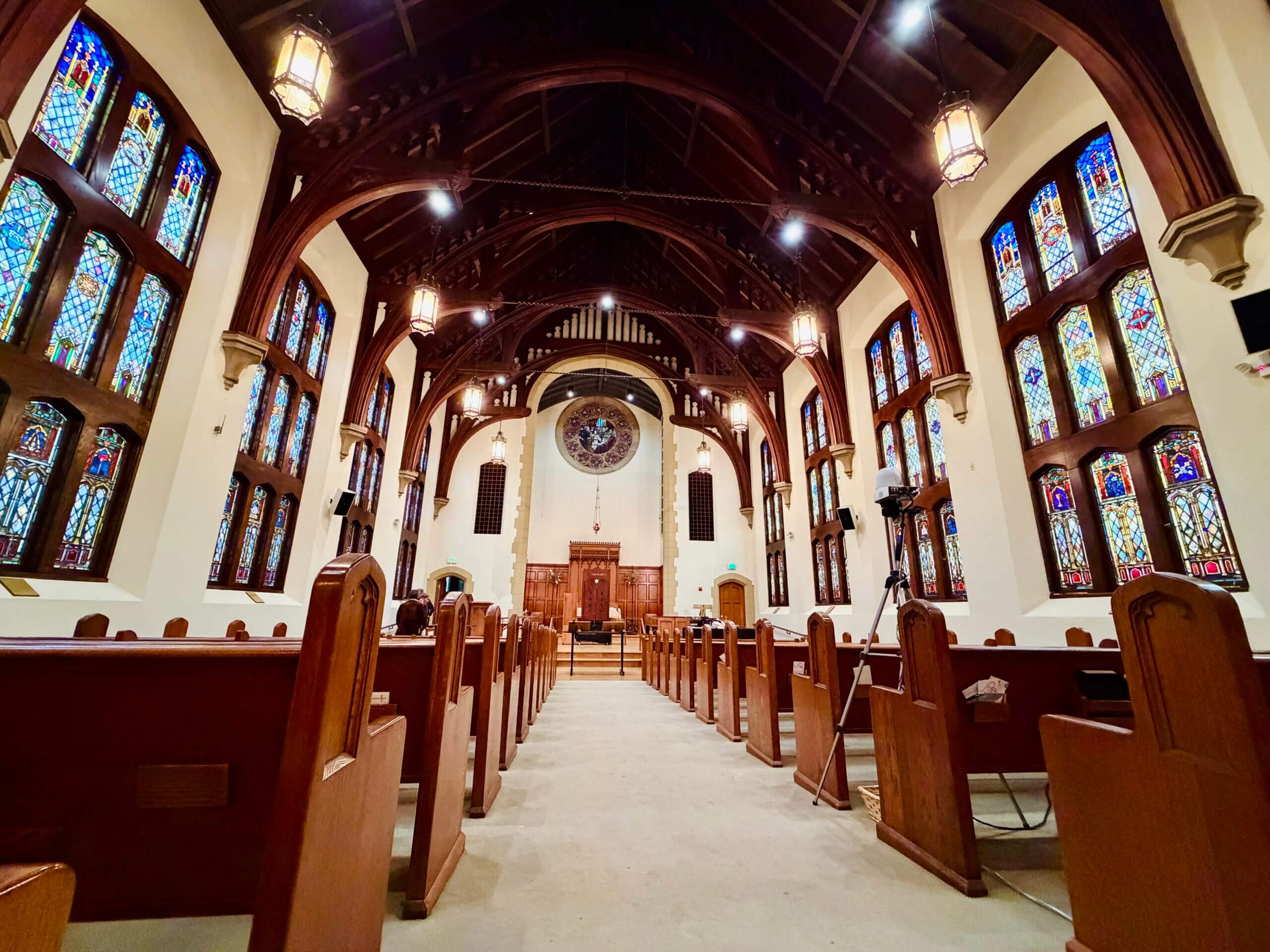
PASADENA — A year after fire reduced the Pasadena Jewish Temple and Center to ash, Cantor Ruth Berman Harris stands in the rain on the empty lot where it once stood. Beneath her boots, the ground is slick; above her, the San Gabriel Mountains fade into fog — the inverse of the dry, wind-driven night when flames tore through this block.
As smoke filled the building, and ash began falling in the parking lot one year ago, Berman searched for her husband through the darkness, calling out to make sure the Torahs were being carried out. Joined by the synagogue’s president and custodian, they worked quickly, loading the 13 scrolls into two cars as the fire, a beast consuming Los Angeles, roared closer. By night’s end, the building was destroyed, the flames claiming it all.
Over the past year, the synagogue has been doing the work of recovery in plain sight and in borrowed space. It has not seen a collapse in membership; as many families have joined since the fire as in the year before it. The calendar has remained full. In 2025, the shul celebrated 25 bar and bat mitzvahs — one nearly every other week — even as services moved to a church chapel across town. And as the community continues to grieve what was lost, leaders are already imagining a rebuilt synagogue designed to better reflect how the congregation lives and gathers now.
For Berman, 55, that rhythm felt familiar.
She grew up in Buenos Aires and lived through two acts of mass violence that targeted the Jewish community there — the 1992 bombing of the Israeli embassy and the 1994 bombing of a Jewish community center, which killed 85 people, including friends of hers. In those moments, she was the one making sandwiches for rescue workers, helping others absorb shock.
The Eaton Fire that razed Pasadena was different.
“What surprised me,” she said, “was how loving and caring and strong and vibrant a community can be in the midst of tragedy. There was no doubt that we were going to be OK.”
Over the past year, she has watched people return to Jewish life who had once drifted away from it — not out of fear, but out of need.
“It surprised me how relevant a Jewish community can be in times of crisis,” she said. “I knew it from books. I had never experienced it.”
Some losses, she knows, cannot be replaced. On her office walls hung artwork painted by her mother. On her desk, a constant presence was a prayer book she had studied from since cantorial school, filled with notes, highlights, and the handwriting of her teachers.
“I can buy another siddur,” she said. “But I can’t replicate their writing.”
She speaks plainly about the trauma. Nightmares. Compartmentalization. What she calls a lockbox she has learned to keep sealed so she can continue doing her job. Only recently, she said, has she begun to feel steady enough to open it — helped by the arrival of a permanent rabbi, and by the knowledge that the community is no longer just surviving.
A temporary sanctuary
Shabbat arrives inside a side chapel at the First United Methodist Church, where the Pasadena Jewish Temple and Center has been gathering since the fire.
During Sukkot, the church opened its courtyard for a sukkah. Shul congregants found themselves explaining the holiday — its temporary walls, its invitation to dwell with uncertainty — to church members who stopped to ask questions. What might once have been an accommodation became, instead, a point of exchange: Jewish ritual practiced openly, and neighbors eager to understand it.
The chapel feels like a sanctuary in its own right. There are no crosses on the walls. The space is rectangular and airy, with wood arches vaulting toward the ceiling like the hull of an inverted ship. Gold-rimmed stained-glass windows run the length of the room on both sides. One of them, inexplicably, bears a purple menorah.
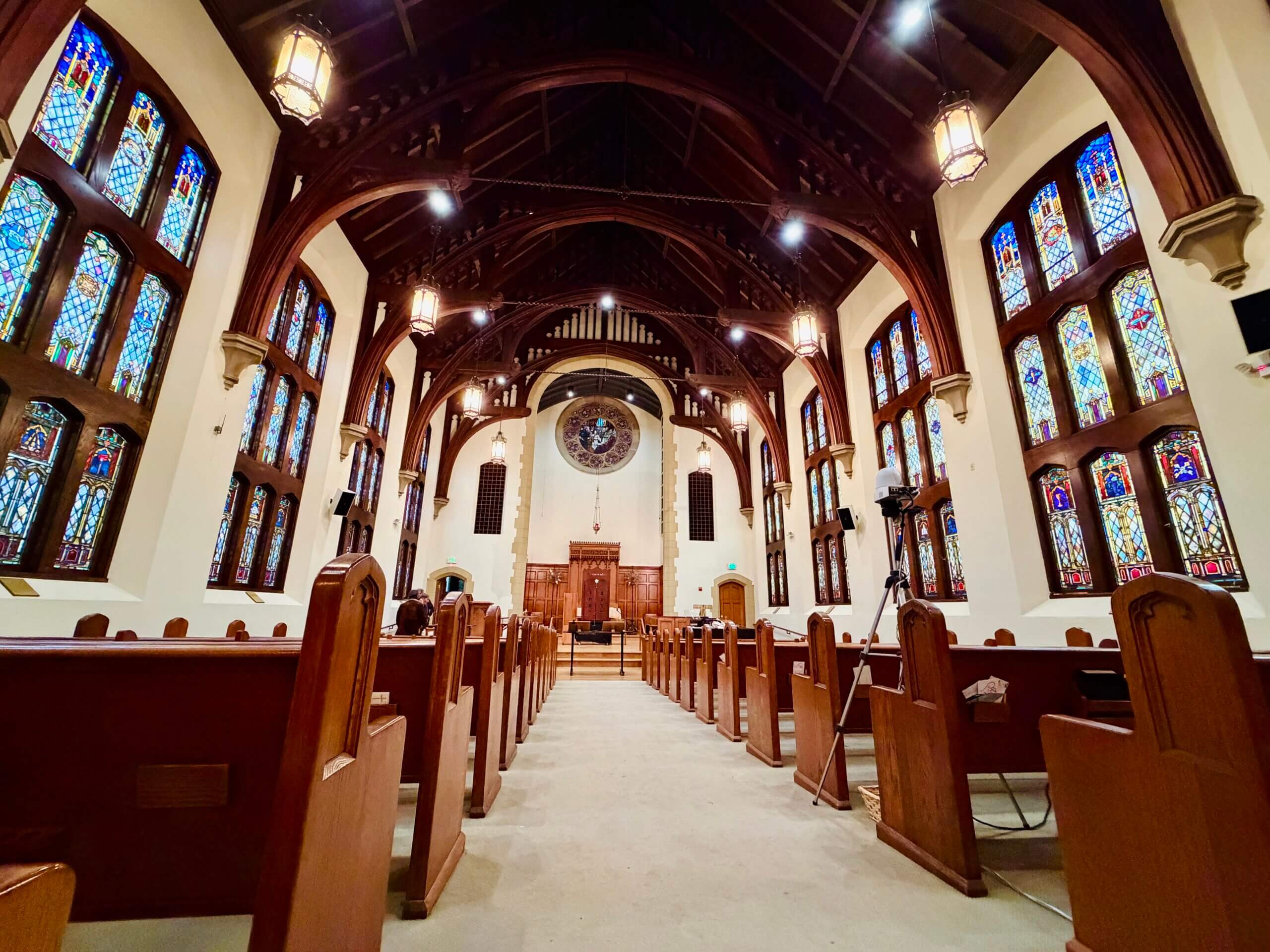
Only small details reveal the building’s Christian life: a New Century Hymnal tucked into the back of each pew, a Bible containing both the Old and New Testaments, a small tithing envelope resting beside it.
About 100 people fill the pews on Saturday morning. At the front of the chapel, Berman and Rabbi Joshua Ratner lead services alongside a bat mitzvah girl, while a guitarist and mandolin player keep the room humming.
The portable ark behind them has an unlikely backstory. It was crafted decades ago by a Los Angeles pediatrician (and father of Forward reporter Louis Keene) who had built it for his own shul which, at the time, was temporarily meeting at a Baptist church.
In recent years, the ark sat unused in the doctor’s garage. After the January 2025 wildfires, the family donated it to Pasadena — carried in and out of the church chapel each week, suddenly suited to a congregation without a permanent home.
For a year now, the Pasadena Jewish Temple and Center has lived this way. “It’s a mishkan,” Ratner said. “A traveling tabernacle.”
As the service continues, Ratner delivers the sermon. He began the job in August, months after the fire, at a moment when the synagogue no longer had a building to offer him — only a congregation in flux.
Ratner, 50, spent his early career as a lawyer before pivoting to the pulpit. He applied for the Pasadena job before the fire, drawn by what he had heard about the community. When the building was destroyed, he thought the search would be called off.
“I assumed that would be the end of it,” he said.
Instead, synagogue leaders doubled down. They wanted a rabbi not after recovery, but in the middle of it.
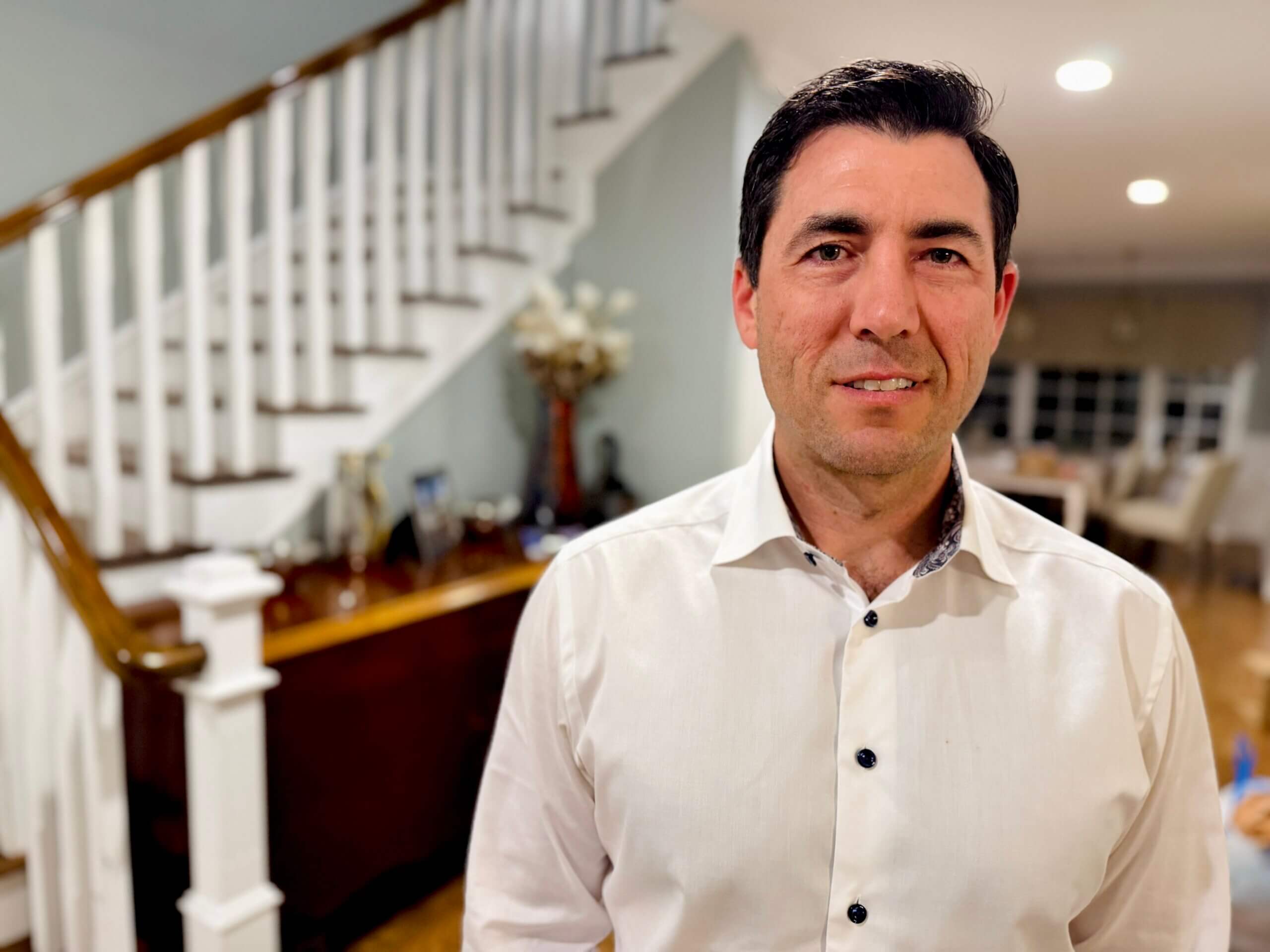
When Ratner visited Pasadena after the fire, he was struck by what he found. Hundreds of people filled Friday night and Shabbat morning services — not out of obligation, but solidarity.
The community, Ratner sensed, was grieving, but not frozen. “There’s no doubt or existential fear,” he said. “While we’re still mourning what we lost, we’re already morphing into the future.”
Since his arrival, the momentum has held. “Every week almost feels new,” Ratner said. “Like a simcha.”
A family without a home
For some of the shul families, the losses were not only communal.
In neighboring Altadena, Heather Sandoval Feng and her husband, Oscar, stand on the front steps of what used to be their home. The fire left behind a pile of rubble and a concrete staircase leading nowhere.
Three weeks after the fire destroyed their house, their daughter Hannah became a bat mitzvah.
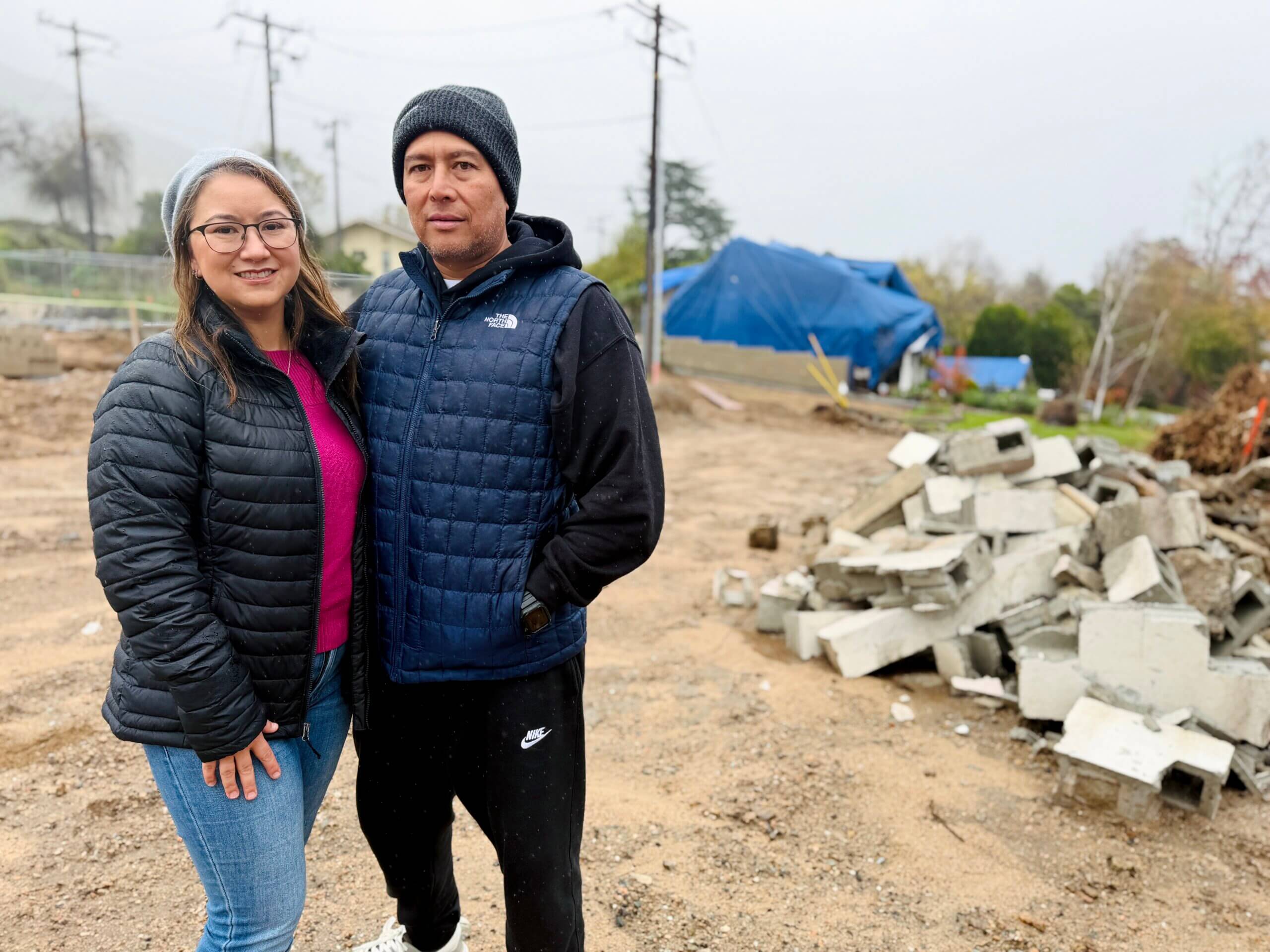
Like the congregation itself, the family was displaced. They moved in with Heather’s parents nearby. Life became provisional — borrowed bedrooms, borrowed routines, borrowed time. And yet Hannah’s bat mitzvah went ahead as planned, held in the church chapel where the Pasadena Jewish Temple and Center now gathers each Shabbat.
“There was something strangely comforting about that,” Heather said. “The synagogue had lost its home. We had lost ours. We were going through it together.”
Oscar described the year as one long exercise in adjustment — learning how to live without the assumption of permanence. “We’ve had to be a little nomadic,” he said, looking over as their son, Noah, 10, played in the dirt where his bedroom once stood.
The bat mitzvah ceremony became a life lesson — not just about Torah, but about continuity without certainty. “It turned into a teachable moment,” Oscar said.
What sustained them, both parents said, was the congregation’s steadiness. Tutors kept showing up. Shabbat kept coming. People checked in — not performatively, but persistently. The synagogue did not treat their family as a separate tragedy. It folded them into its own.
“There was never a question of whether things would still happen,” Heather said. “The answer was always: Of course they will.”
Holding steady and looking ahead
In the months after the fire, synagogue leaders worried about what displacement might do to membership. Instead of a drop-off, the numbers told a different story. Since the fire, the Pasadena Jewish Temple and Center has welcomed 49 new families — roughly the same number it added the year before. A handful of families have moved away, some because of the fire itself, but overall membership has remained remarkably consistent, hovering around 430 families.
An added bonus: Some relatives who flew in from out of town for bar and bat mitzvahs found themselves so moved by the congregation that they later joined it themselves.
What surprised Melissa Levy, the synagogue’s executive director, was not just the endurance, but the momentum behind it. Families kept calling. Local Jews who were not members wanted to now join the congregation.
“It’s amazing,” she said, “but it’s also a testament to how strong this community already was.”
That strength has been built over more than a century.
Founded in 1921 as Temple B’nai Israel, the congregation moved onto its current property in 1941, a campus of Mission Revival–style buildings arranged in a U-shape — a midcentury synagogue just beyond the urban sprawl of Los Angeles that had expanded over decades to include classrooms, playgrounds, and a social hall. At one point, it even had a swimming pool. During World War II, the synagogue hosted USO-style dances for servicemen stationed nearby.
Members have included NASA engineers, Caltech professors, and those who built their dreams among the stars. “I used to joke that growing up in Pasadena, our shul had doctors, lawyers and rocket scientists,” said Rabbi Alex Weisz, whose family has been members for generations.
As Jewish demographics shifted, the congregation absorbed others — merging with Shomrei Emunah and later Shaarei Torah — eventually becoming the singular Conservative synagogue serving the western San Gabriel Valley.
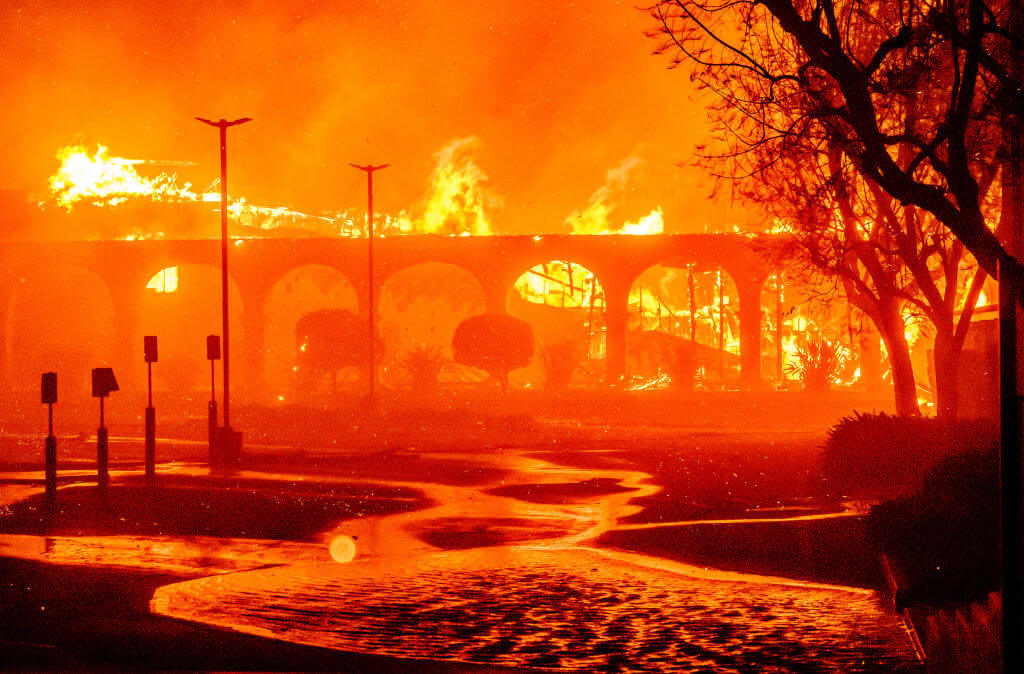
That history now informs the future, and what rises in its place will not be a replica of what was lost. The new building will be more intentional: fewer walls, more flexibility, and spaces designed around how congregants actually spend time together now.
Plans call for open gathering areas where parents can linger when their children are in classes — places to work, talk, or simply stay — rather than treating the synagogue as a drop-off point. There will be more glass and fewer corridors, designed to draw the San Gabriel Mountains into view. Outdoor areas are meant not just for overflow, but for prayer and meditation — quiet spaces that look outward, toward the hills that rise behind Pasadena.
“We were fitting a circle into a square,” Levy said. The new building is being imagined as a place where different generations can overlap rather than pass through on separate schedules.
The goal is not grandeur, but usability. A synagogue that can hold worship and study, celebration and stillness — and that reflects a community that has learned, over the past year, how to gather without relying on walls at all.
The scale of what lies ahead is substantial. Rebuilding is expected to cost tens of millions of dollars. Insurance will cover roughly half of that amount — money that was paid out quickly and is already in an account collecting interest — but the rest will need to be raised by the congregation itself. The cost is immense, especially for middle-class Pasadena, but leaders describe it as something to be faced, not feared.
They hope to open the new building by the High Holidays of 2028 — not as a return to what was lost, but as an expression of what the community has become. For now, those plans exist alongside grief. But Jewish life continues — weekly, seasonally, insistently.
Asked what it feels like to stand at the site of the fire a year later, Cantor Berman pauses.
“I don’t really have words for it,” she said.
Rain dots the cracked pavement beneath her feet, darkening the outline of the lot where the synagogue once stood.
After the fire — after the Torahs had been rescued and the building reduced to rubble — she returned to the site and took one small thing that was still standing. Not a ritual object. Not a book. It was the sign from her parking space — Reserved for the Cantor — something ordinary that had marked the rhythm of returning to the same place, day after day.
There were other losses, she said. Some she remembers clearly. Others she does not.
“The things I don’t remember having,” she said, “will haunt me forever.”
The post She helped rescue the Torahs from their burning synagogue. A year later, Pasadena’s mishkan is thriving. appeared first on The Forward.
Uncategorized
I grew up in Venezuela. Will Maduro’s ouster bring my Jewish community the security we need?
For Venezuelan Jews — inside the country and across the diaspora — the United States’ shocking removal of President Nicolás Maduro from power marks an inflection point in a long and painful chapter marked by vulnerability, fear and exile.
Venezuela was once home to one of Latin America’s most vibrant Jewish communities. I know this because I was raised there. A generation of Jews, including my own grandparents, found refuge from the Holocaust in Venezuela, at a time when many other countries closed their doors.
Venezuela’s relationship with the Jewish people was not only about providing a refuge for Jews following the Holocaust. It was also diplomatic. In November 1947, Venezuela voted in favor of United Nations resolution 181, which supported the creation of independent Jewish and Arab states in Palestine, leading to the creation of the State of Israel. For the Venezuelan Jewish community, this vote has long stood as a point of pride, and an affirmation of belonging.
For decades, Venezuela and Israel had a natural, mutually beneficial diplomatic relationship. For example, in 1961 the two signed a technical agricultural agreement as part of Venezuela’s push to modernize rural development.
High level visits between government officials between the two countries were common. I vividly remember shaking then-foreign minister Shimon Peres’s hand when he visited the Jewish Day School in Caracas in 1995 as part of a state visit. As a high school student, it was exciting to see firsthand how an Israeli statesman carved time out of his agenda to come see my distant country’s Jewish community. And, looking back, that visit underscored how normal and secure Jewish life once felt in Venezuela, in stark contrast to the fear and isolation that would follow years later.
All this began to change after Hugo Chávez came to power in 1999.
Under Chávez, relations with Israel steadily deteriorated, shaped by Chávez’s ideological commitment to global left-wing movements that, as a legacy of the Cold War, aligned themselves with Arab states and framed opposition to Israel as a core political stance. Diplomatic relations between the two nations were formally severed during the 2009 Israel-Hamas confrontation known as Operation Cast Lead.
That wasn’t just a major foreign policy shift; it also marked the onset of a political climate in which Venezuelan Jews felt increasingly exposed. That vulnerability reached a terrifying peak that same year, when armed assailants desecrated the Tiferet Israel synagogue in Caracas, ransacking sacred spaces; destroying religious objects; and scrawling threats and antisemitic slogans on the walls.
It was not an isolated act of vandalism. It was a message of hostility and intimidation, received as such by a community that already felt abandoned by the state.
In 2010, Chavez amped up his anti-Israel rhetoric in reaction to that year’s confrontation between the IDF and the Gaza Freedom Flotilla by declaring “maldito sea el Estado de Israel” — “cursed be the State of Israel” — on national television. When Maduro rose to power in 2013, following Chavez’ death, he did not reverse this trajectory. He accelerated it.
Under his rule, anti-Zionism repeatedly crossed into open antisemitism — both in language and in effect. Not long ago, while talking about Israel’s war in Gaza, Maduro claimed he had “real Jewish blood … unlike Israeli Jews” whom he described as “foreigners from Poland,” reviving classic tropes about authenticity, belonging and conspiracy that have long been used to delegitimize Jews and Israel.
After the Hamas attack of Oct. 7, 2023, Maduro’s regime openly embraced the “genocide” narrative against Israel. His government even compared Israel to Nazi Germany. The consequences of these statements touched Jews across Venezuela. Synagogues and Jewish institutions were often vandalized and defaced with hateful slogans. The targets were not Israeli diplomats — there were none — but Venezuelan Jews.
That distinction matters. Being Jewish has become more difficult in advanced democracies like the U.S. since the Oct. 7 attack. So imagine what it felt like in a country governed by an authoritarian regime that is openly anti-Zionist and routinely fails to distinguish between Jews and Israelis. The family and friends I still have in Venezuela navigate daily life with quiet caution, finding ways to remain Jewish while staying unnoticed, weighing every decision about when to gather, when to speak, and when silence feels safer.
But most of the Jewish community opted to be part of a wave of more than 8 million Venezuelan migrants — about 20% of the country’s population — who decided to seek a new life in other countries.
Will that wave of departures ebb now that Maduro has been forcibly removed from power by the U.S.? The honest answer is: we don’t know. Two decades of institutionalized hostility have left deep scars. And the early signs about the next era are discouraging. In her first televised addresses, new interim president Delcy Rodriguez — Maduro’s former second-in-command — blamed “Zionist” influences for the U.S. military operation. Old reflexes die hard.
And yet, Venezuelans, including Venezuelan Jews, are cautiously optimistic. Not celebratory. Not naïve. But hopeful that this may finally be the beginning of the end of a cruel dictatorship that devastated an entire nation — economically, socially and morally. If free and fair elections follow — still a significant “if”—Venezuela may have a chance to return to democracy, and with it, to its historical commitment to pluralism and coexistence.
That could also bring an opportunity to rethink Venezuela’s relationship with Israel — not only morally, but also strategically.
Israel could be a natural ally in Venezuela’s reconstruction. It is a global leader in water management, agriculture, health technology, cybersecurity, and energy innovation — precisely the areas in which Venezuela faces acute shortages after years of collapse.The building blocks are already there: Even amid today’s diplomatic wreckage, trade still exists at a small scale — evidence that the bridge can be rebuilt when politics allows it.
In fact, opposition leader (and 2025 Nobel Peace Prize winner) María Corina Machado has already stated that a democratic Venezuela would reopen its embassy in Israel — in Jerusalem, in fact. That is a clear signal that, in the eyes of at least some influential leaders, antisemitism has no place in the country’s future.
For Venezuelan Jews, this moment is not about geopolitics. It is about whether the country they once called home can again be a place where being Jewish is not a liability.
Hope, for now, is cautious. But after so many years of fear, even cautious hope is something new.
The post I grew up in Venezuela. Will Maduro’s ouster bring my Jewish community the security we need? appeared first on The Forward.
Uncategorized
Jewish New Yorkers say concerns about Mamdani are real, new poll shows. Most other voters say they’re overblown.
A majority of New York City voters believe that Mayor Zohran Mamdani’s harsh criticism of Israel is a legitimate policy disagreement and that elected officials should challenge U.S. support for Israel, even if it upsets some voters, a new poll found. Views differ sharply among Jewish New Yorkers.
The Honan Strategy Group survey of 703 voters, conducted from December 4 to 12, found that 55% of non-Jewish respondents say Jewish concerns about feeling threatened by Mamdani’s statements on Israel are an overreaction fueled by politics. By contrast, among the smaller sample of 131 Jewish respondents, 53% say they have reason to feel that way, given Mamdani’s statements and associations.
The poll, first shared with the Forward, was conducted via text-to-web and analyzed separately for Jewish and non-Jewish respondents. The overall sample has a reported margin of error of plus or minus 3.7%, while the Jewish subsample has a margin of error of plus or minus 8.6%.
New York City is home to the largest Jewish community outside of Israel. Jewish voters make up an estimated 15% of the electorate. NYPD data shows that antisemitic acts made up 57% of all reported hate crimes citywide in 2025.
Mamdani, a democratic socialist whose strident criticism of Israel deepened rifts within New York City’s Jewish community during the election, spent the months after his surprising Democratic primary victory in direct outreach to clergy and prominent Jews to ease concerns about his record.
But his support for the Boycott, Divestment and Sanctions movement and his refusal to explicitly condemn the “globalize the intifada” slogan used at some pro-Palestinian protests, perceived by many as a call for violence against Jews, fueled backlash. The city’s Jewish voters were divided in the competitive mayoral election. Concern intensified after Mamdani’s mixed response to a demonstration outside Park East Synagogue that included anti-Israel and antisemitic slogans, in which he questioned the use of a sacred place for an event promoting migration to Israel.
Mamdani reignited deep suspicions about what kind of mayor he intends to be within hours of taking office, revoking two executive orders by former Mayor Eric Adams that many Jews felt supported them and Israel. Mamdani insisted that the move was not intentional or targeted at the Jewish community. He said he wanted to begin his administration with a “clean slate,” clearing away measures signed by Adams so he could enact his own agenda that he said would protect Jewish New Yorkers. But that explanation was met by skepticism. The New York Times reported that the revocations were planned well in advance and rolled out in a way that aimed to minimize backlash.
In a rare joint statement, a coalition of mainstream Jewish organizations said they were deeply concerned by Mamdani’s actions. It called for “clear and sustained leadership that demonstrates a serious commitment to confronting antisemitism” and one that ensures that the mayor’s office is not used to advance BDS.
The Honan Strategy Group found that 53% of non-Jewish voters and 47% of Jewish voters think Mamdani’s criticism of Israel reflects legitimate policy disagreements over the Israeli-Palestinian conflict. However, 40% of Jewish voters believe it crosses a line and fuels antisemitism. Similarly, 51% of Jews view Mamdani’s rise as a troubling sign that antisemitism is being normalized, while 61% of non-Jewish voters see it as evidence of healthy debate and diversity. Fifty-four percent of Jewish voters say Mamdani’s positions deepen division and tension.
Pollster Bradley Honan described the positions on Mamdani and Israel as a “temperature gap” between communities in the Mamdani era. “This issue is turning into a defining political fault line in New York City,” he said. “Jewish voters are significantly more likely to say it’s making public antisemitism more acceptable and driving division.”
Mamdani has repeatedly defended his stance on Israel and the administration’s appointments of individuals who share his views. “We must distinguish between antisemitism and criticism of the Israeli government,” Mamdani said during a recent press conference, responding to an ADL report that scrutinized many of his transition team members. He also accepted the resignation of his newly-appointed director of appointments, Catherine Almonte Da Costa, after her past antisemitic posts resurfaced.
Mamdani kept open the recently created mayor’s office to combat antisemitism that pursued the measure he revoked adopting the controversial International Holocaust Remembrance Alliance definition of antisemitism, which considers most forms of anti-Zionism as antisemitic. Mamdani also promised to divest from city investments in Israel and pledged to arrest Prime Minister Benjamin Netanyahu if he comes to New York in compliance with an International Criminal Court warrant.
The poll shows that Jews and non-Jews hold sharply different views on Mamdani’s foreign policy focus. Large majorities of Jewish voters — 71% and 69% respectively — say that speaking out against Israel’s military actions is likely to be viewed as antisemitic and that arresting Netanyahu would harm New York’s global standing. By contrast, 51% of non-Jewish voters say criticism of Israel reflects legitimate policy debate, 53% say it is appropriate for leaders to challenge U.S. support for Israel, and 40% say Mamdani has a moral obligation to uphold international human rights standards by ordering Netanyahu’s arrest.
In his inauguration speech, Mamdani reassured Jewish New Yorkers, “some who view this administration with distrust or disdain,” that he will protect them.
The post Jewish New Yorkers say concerns about Mamdani are real, new poll shows. Most other voters say they’re overblown. appeared first on The Forward.

